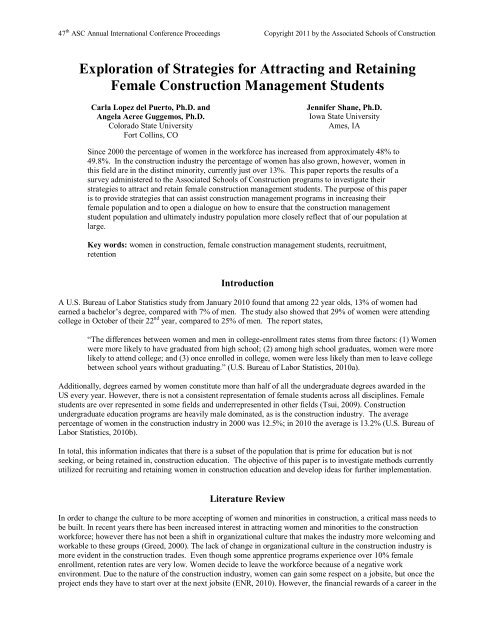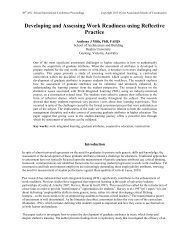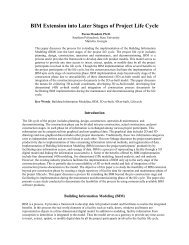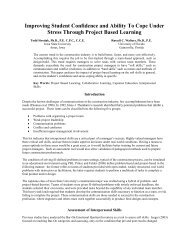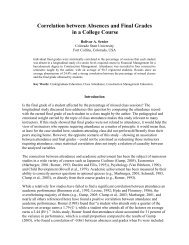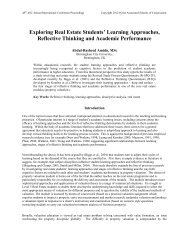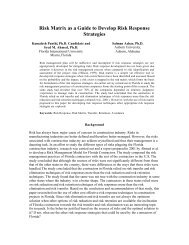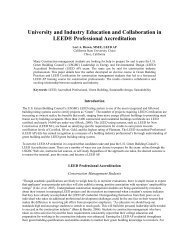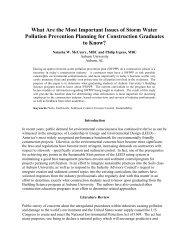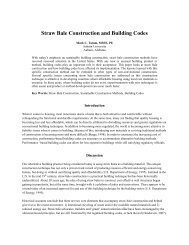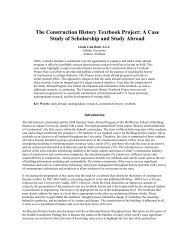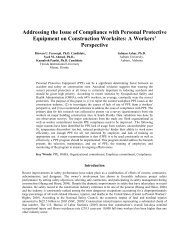Exploration of Strategies for Attracting and Retaining Female ...
Exploration of Strategies for Attracting and Retaining Female ...
Exploration of Strategies for Attracting and Retaining Female ...
You also want an ePaper? Increase the reach of your titles
YUMPU automatically turns print PDFs into web optimized ePapers that Google loves.
47 th ASC Annual International Conference Proceedings Copyright 2011 by the Associated Schools <strong>of</strong> Constructionconstruction industry are much higher than traditional careers <strong>for</strong> women without a college degree. For example, theaverage annual salary <strong>for</strong> cashiers is $19,000, while the average annual salary <strong>of</strong> painters is $44,000 (ENR, 2010).The authors conducted a literature review <strong>of</strong> strategies to attract <strong>and</strong> retain women in non-traditional careers <strong>for</strong>women including but not limited to engineering, sciences <strong>and</strong> finance. The following strategies emerged from theliterature review as keys to successfully attract <strong>and</strong> recruit students: mentoring, targeting the audience <strong>and</strong> thecommunity, <strong>and</strong> countering negative stereotypes.MentoringA <strong>for</strong>mal mentoring program can provide mentees with resources, guidance, support <strong>and</strong> encouragement (Putshe,Storrs, Lewis & Haylett, 2008). Successful female mentoring programs are based on the feminist mentoring modelthat encourages a collaborative environment in which the mentee is empowered <strong>and</strong> has an active participation. Thismodel contrasts the traditional mentoring model in which the mentor is the holder <strong>of</strong> all knowledge <strong>and</strong> the menteeis a passive participant. The feminist mentoring model benefits both the mentor <strong>and</strong> the mentee by providingcognitive <strong>and</strong> emotional development opportunities <strong>and</strong> personal satisfaction to both groups (Putshe, et al., 2008).The success <strong>of</strong> <strong>for</strong>mal mentoring programs is due in large part to the commitment <strong>and</strong> dedication <strong>of</strong> the coordinatorthat matches the mentors with the mentees <strong>and</strong> ensures that the program meets the mentees’ needs. Formalmentoring programs are more effective than in<strong>for</strong>mal mentoring programs in which disadvantaged populations reachout to mentors because some students in this group are not likely to reach out to mentors in a non-structuredenvironment (Putshe, et al., 2008).Targeting the Audience <strong>and</strong> CommunityTraditional marketing approaches <strong>for</strong> construction management education programs should be adapted to attractfemale students. <strong>Female</strong> students are generally looking <strong>for</strong> programs that support their passion <strong>for</strong> research <strong>and</strong>inquiry (Santonocito, 2010). They are drawn increasingly to socially responsible programs that contribute to thewell-being <strong>of</strong> their community <strong>and</strong> society as a whole (Santonocito, 2010). Adapting the marketing approach to suitthe interests <strong>of</strong> prospective students contributes to a diversified student population. Local community groups areuseful partners in advocating <strong>for</strong> <strong>and</strong> reaching underrepresented groups. Since worldviews <strong>and</strong> career selectiondevelop early in a student’s life, it is important to reach out to grade school <strong>and</strong> middle school children. By the timestudents are in high school, they have already made their selection.Countering Negative StereotypesWomen in non-traditional careers face many obstacles in their careers. Negative environments have been linked todecreased satisfaction with the career path <strong>and</strong> ultimately attrition (Setles, Cortina, Stewart, & Malley, 2007).Women in non-traditional careers <strong>of</strong>ten work in environments that are sexist or openly hostile. Even if this is not thecase, unspoken sexist or hostile environments can also have a negative effect on women’s satisfaction with theworkplace. (Setles et al., 2007). A change in culture is needed to retain women in the construction industry(Menches & Abraham, 2007). Per Menches <strong>and</strong> Abraham (2007), the main barriers to success <strong>for</strong> women in theconstruction industry are:Slow career progression,Difficulty balancing work-family pressures,Male dominance,Changing jobs to overcome slow career progression,Culture <strong>of</strong> conflict <strong>and</strong> aggression.MethodologyThe methodology <strong>for</strong> this research involved several activities. The objective was achieved through literature review,an open-ended survey, follow up interviews, <strong>and</strong> finally a brainstorming session. A literature review was conductedto identify methods <strong>of</strong> recruiting <strong>and</strong> retaining women in education programs <strong>for</strong> non-traditional fields <strong>for</strong> women.
47 th ASC Annual International Conference Proceedings Copyright 2011 by the Associated Schools <strong>of</strong> ConstructionIn<strong>for</strong>mation was mostly found regarding engineering <strong>and</strong> the sciences with limited in<strong>for</strong>mation on constructioneducation programs.Following the literature review, an email was sent in spring <strong>of</strong> 2010 to members <strong>of</strong> the Associated Schools <strong>of</strong>Construction (ASC) e-mail list. Participants were asked to share in<strong>for</strong>mation about the strategies they are using toattract <strong>and</strong> retain female construction management students. The email specifically stated interest in pre-collegerecruiting ef<strong>for</strong>ts, interactions with faculty outside the classroom, types <strong>of</strong> retention ef<strong>for</strong>ts (student-led, faculty-led,<strong>and</strong> industry-led), women-focused construction management clubs (<strong>for</strong>mal or in<strong>for</strong>mal organizations) <strong>and</strong> fundingsources <strong>of</strong> these ef<strong>for</strong>ts. ASC has over 100 member schools. Responses from eighteen schools were received. Themajority <strong>of</strong> respondents stated that even though they did not have a program targeting female constructionmanagement students, they would like to see such program implemented at their university. Following the review <strong>of</strong>the survey responses, in-depth telephone interviews were conducted with respondents who asked to be contacted toprovide clarification to their responses.The results <strong>of</strong> the literature review, survey, <strong>and</strong> the in-depth interviews were presented at the Colorado StateUniversity 10 th Annual Diversity Conference in September 2010. The session was divided into two sections: (1) apresentation <strong>of</strong> the findings to date, <strong>and</strong> (2) a working session with participants to brainstorm about strategies toattract <strong>and</strong> retain female students in our program.<strong>Strategies</strong> <strong>for</strong> Increasing the Number <strong>of</strong> <strong>Female</strong> Construction Management StudentsBased on the literature review, survey responses, interviews, <strong>and</strong> the working session, the authors believe that thefollowing strategies will increase female representation in construction management programs:Mentoring: The main factor that determines the success <strong>of</strong> a mentoring program is a good programcoordinator that is able to match a mentor with mentees. In construction management programs, mentorscan be female faculty. Another alternative is peer mentoring: pairing junior <strong>and</strong> senior female students withfreshman <strong>and</strong> sophomore female students so that older students can act as mentors <strong>and</strong> role models toyounger students.Targeting the Audience <strong>and</strong> Community: Recruitment programs have to be tailored to women. Thereasons why women decide to pursue a career in the construction industry are different than those <strong>of</strong> men.Women are attracted to construction because they want to help others. Programs such as Habitat <strong>for</strong>Humanity <strong>and</strong> other programs that benefit the community must be highlighted when recruiting women.Countering Negative Stereotypes: <strong>Female</strong>s in construction management are <strong>of</strong>ten frustrated by slowcareer progression, work-life balance, <strong>and</strong> a masculine culture <strong>of</strong> conflict <strong>and</strong> aggression (Menches &Abraham, 2007). Construction management programs <strong>and</strong> construction companies need to promote positiveimages, role models, <strong>and</strong> use outreach to directly address negative perceptions in the construction industry.Hire <strong>Female</strong> Faculty: <strong>Female</strong> construction management faculty can serve as role models to femalestudents <strong>and</strong> influence both male <strong>and</strong> female construction management students’ perception <strong>of</strong> who is aconstruction management pr<strong>of</strong>essional.Recruitment by <strong>Female</strong> Faculty: Recruitment ef<strong>for</strong>ts are more effective if students can relate to someonelike them. <strong>Female</strong> grade school, middle school, <strong>and</strong> high school students would be more likely to pursueconstruction management degrees if female construction management faculty went to their schools <strong>and</strong>shared their experiences with them.Establish Women in Construction Clubs: These clubs support both the pr<strong>of</strong>essional <strong>and</strong> social needs <strong>of</strong>female construction management students by providing an environment <strong>of</strong> camaraderie in which studentscan invite speakers to discuss issues that interest them, enjoy a ladies’ night out, participate in constructionjobsite visits, etc.
47 th ASC Annual International Conference Proceedings Copyright 2011 by the Associated Schools <strong>of</strong> ConstructionCamps <strong>for</strong> Prospective <strong>Female</strong> Students: Camp experiences encourage prospective students to explorethe construction management field. Camps can also answer prospective students’ <strong>and</strong> parents’ questions<strong>and</strong> concerns. This allows them to make educated decisions about the students’ career choices.Promote the Program to High School Advisors: High school advisors <strong>of</strong>ten share the commonmisconception that the construction management industry is not suited <strong>for</strong> females. In order to counter thisnegative stereotype, construction management programs <strong>and</strong> construction management companies must beproactive <strong>and</strong> educate advisors about the difference between construction labor <strong>and</strong> constructionmanagement. Increasing underst<strong>and</strong>ing among high school advisors regarding the constructionmanagement pr<strong>of</strong>ession may lead to more high school advisors recommending construction managementdegrees to their advisees.ConcernsThere are several concerns with implementing some <strong>of</strong> the identified ideas. One is the impact this will have onfemale faculty. Many if not all <strong>of</strong> these strategies rely on active participation <strong>and</strong> support <strong>of</strong> female facultymembers. There are few female construction faculty members <strong>and</strong> even fewer who are tenured. These ideas centeron service activities, many <strong>of</strong> them time-consuming. Many universities that house construction managementprograms weigh research heavily in the tenure <strong>and</strong> promotion decision. Funded research takes on additionalimportance in times <strong>of</strong> increasingly tight budgets <strong>for</strong> higher education. Due to their high visibility, women are <strong>of</strong>tenasked to participate in committees <strong>and</strong> recruitment ef<strong>for</strong>ts to increase representation <strong>of</strong> their gender (Menges &Exum, 1983). Although service is a requirement <strong>for</strong> tenure, an emphasis on service can be to the detriment <strong>of</strong>research production. If a tenure-track female faculty member establishes a strong recruitment <strong>and</strong> retention programbut is unable to secure tenure, the benefits <strong>of</strong> years <strong>of</strong> ef<strong>for</strong>t may be lost when that faculty member must leave theprogram. There needs to be a strong advocate <strong>for</strong> tenure-track female faculty members in the program to make surethat their time spent on service activities is not detrimental to their teaching <strong>and</strong> research activities.Another concern is the scale <strong>of</strong> the strategy. Should female recruitment <strong>and</strong> retention programs reside at theundergraduate program level, college level, university level, or at the national level? Are there regional issues thataffect recruitment <strong>and</strong> retention? Would a program with a strong female recruitment <strong>and</strong> retention program in aparticular state or region entice female students who may have otherwise considered their local constructioneducation program? If the goal is to truly increase the number <strong>of</strong> women in the construction industry by increasingthe number <strong>of</strong> women in construction programs, then there is a strong argument <strong>for</strong> a concerted ef<strong>for</strong>t at the nationallevel, possibly with supporting recruitment <strong>and</strong> retention programs tailored to each undergraduate program.On a deeper level, the industry still has an image problem with negative stereotypes about construction as apr<strong>of</strong>ession. In the construction management program at Colorado State University, most students who enter asConstruction Management majors have chosen the major because they have one or more relatives in the constructionindustry. There are many high school students (<strong>and</strong> their parents) without construction industry knowledge that maylook towards business or engineering programs without considering construction management as a career due to thenon-pr<strong>of</strong>essional image <strong>of</strong> the construction industry. This coupled with it being seen as a “man’s pr<strong>of</strong>ession” makesit even more challenging to attract female students. This is an issue that is best addressed at the national level tochange the perception <strong>of</strong> the construction industry as a pr<strong>of</strong>ession that applies both business <strong>and</strong> technical skills toimprove society.DiscussionThis research on strategies <strong>for</strong> recruiting <strong>and</strong> retaining female students in construction management programs wasper<strong>for</strong>med to improve diversity in the construction management program at Colorado State University. Figure 1shows the significant discrepancy between females at the university <strong>and</strong> in the construction managementdepartment. Over the past 10 years, the proportion <strong>of</strong> female undergraduate students at the university has rangedfrom 51.0% to 52.3% with an average <strong>of</strong> 51.6%. In this same time frame, the proportion <strong>of</strong> female undergraduateconstruction management degrees conferred has ranged from 4.6% to 12.6% with an average <strong>of</strong> 7.9%.
2000-012001-022002-032003-042004-052005-062006-072007-082008-092009-1047 th ASC Annual International Conference Proceedings Copyright 2011 by the Associated Schools <strong>of</strong> Construction60.00%50.00%40.00%30.00%20.00%% <strong>Female</strong> UniversityStudents% <strong>Female</strong> CM Degrees10.00%0.00%Figure 1: Percent female Colorado State University students <strong>and</strong> percent female Construction Management degreesconferred in academic years 2000-01 through 2009-10Figure 2 shows the number <strong>of</strong> construction management degrees conferred by gender. For the past 10 years, thenumber <strong>of</strong> undergraduate construction management graduates annually has ranged from 119 to 293 with an average<strong>of</strong> 182. In this same time frame, male graduates annually have ranged from 104 to 273 with an average <strong>of</strong> 168 <strong>and</strong>female graduates annually have ranged from 7 to 25 with an average <strong>of</strong> 14.350300250200150100<strong>Female</strong> BSCM DegreesMale BSCM Degrees500Figure 2: Number <strong>of</strong> male <strong>and</strong> female Bachelor Degrees in Construction Management conferred in academic years2000-01 through 2009-10 at Colorado State UniversityAt Colorado State University, the Construction Management Department is not housed in an Architecture,Engineering, or Business College. Instead, it is housed in the College <strong>of</strong> Applied Human Sciences, which promotesitself as a college that is “human centered with a focus on educating students <strong>for</strong> people oriented pr<strong>of</strong>essions” <strong>and</strong>whose programs are “aimed at improving the quality <strong>of</strong> life <strong>for</strong> all people.” Programs within the college that <strong>of</strong>ferundergraduate degrees include: apparel <strong>and</strong> merch<strong>and</strong>ising, family <strong>and</strong> consumer sciences, health <strong>and</strong> exercisescience, human development <strong>and</strong> family studies, interior design, nutrition <strong>and</strong> food science, restaurant <strong>and</strong> resortmanagement, social work, <strong>and</strong> construction management. Except <strong>for</strong> construction management, each <strong>of</strong> theseprograms has a majority female enrollment. Unlike most <strong>of</strong> these majors, a degree in construction management will
47 th ASC Annual International Conference Proceedings Copyright 2011 by the Associated Schools <strong>of</strong> Constructionenable a student to get paid well <strong>for</strong> improving the lives <strong>of</strong> others. Figure 3 shows the average starting salary <strong>for</strong>bachelor degree graduates from in the College <strong>of</strong> Applied Human Sciences at Colorado State University. Theconstruction management average starting salary is the highest in the College <strong>of</strong> Applied Human Sciences <strong>and</strong>fourth highest at Colorado State University. As is can be seen, the financial rewards <strong>of</strong> construction management, anon-traditional career <strong>for</strong> women, are significantly higher.$- $10,000 $20,000 $30,000 $40,000 $50,000 $60,000Apparel & Merch<strong>and</strong>isingFamily & Consumer SciencesHealth & Exercise ScienceHuman Development & Family StudiesInterior DesignNutrition & Food ScienceResaurant & Resort ManagementSocial WorkConstruction Management$26,700$33,000$28,700$32,200$35,000$23,600$32,500$27,800$53,000Figure 3: Projected starting salaries <strong>for</strong> College <strong>of</strong> Applied Human Sciences graduates at Colorado State Universityin 2009.The results <strong>of</strong> this research in combination with the strategic plan <strong>for</strong> our program have helped to <strong>for</strong>mulate the plan<strong>for</strong> female recruitment <strong>and</strong> retention.Conclusions<strong>Attracting</strong> <strong>and</strong> retaining female construction management students is an ef<strong>for</strong>t that requires commitment <strong>and</strong>patience. However, if we want to have a construction work<strong>for</strong>ce that mirrors our society we need to make this ef<strong>for</strong>ta priority. Below are some specific strategies that the construction management program at Colorado StateUniversity has undertaken.The construction management program at Colorado State University has total <strong>of</strong> 568 undergraduate ConstructionManagement majors, out <strong>of</strong> which 46 (8%) are female. The department has ten student clubs that help studentsengage in their pr<strong>of</strong>essional interests. In 2004, the Women in Construction (WIC) club was established to providepr<strong>of</strong>essional <strong>and</strong> social opportunities <strong>for</strong> those interested in supporting women in the construction industry.Membership is not limited to women, but since its inception, the group has only had female members. There arecurrently 31 WIC members. In other words, 67% <strong>of</strong> all female undergraduate construction management students aremembers <strong>of</strong> WIC. Each year, the WIC group is a small but active group <strong>of</strong> women who have a balance <strong>of</strong>pr<strong>of</strong>essional <strong>and</strong> social activities. Most <strong>of</strong> the construction management student groups have monthly meetings that<strong>of</strong>ten center on an industry speaker. WIC hosts an industry speaker monthly. In addition, they meet a second timeduring each month <strong>for</strong> a purely social activity. To help increase membership this past fall, the club leadership senth<strong>and</strong>written notes to all the female construction management <strong>and</strong> pre-construction management majors. Attendanceat the first meeting was tremendous.This year, the Colorado State University construction management department initiated the CM Cares programwhich strengthens the department’s tie to the community through construction-based service learning projects. Incollaboration with industry sponsors, students in various construction management courses will apply their newlylearned skills on community-improvement projects. Planning, estimating, scheduling, <strong>and</strong> procurement are justsome <strong>of</strong> the skills needed <strong>for</strong> the projects. It is intended that students will participate in these service learning
47 th ASC Annual International Conference Proceedings Copyright 2011 by the Associated Schools <strong>of</strong> Constructionprojects throughout their undergraduate program <strong>and</strong> document their ef<strong>for</strong>ts through a service-learning portfolio.When they are ready to graduate, they will be able to share both their résumé <strong>and</strong> service-learning portfolio withprospective employers. Ef<strong>for</strong>ts such as these will help existing <strong>and</strong> prospective students realize that constructionmanagement is a service-oriented pr<strong>of</strong>essions whose members help make the world a better place with their day-todayactions.Future ResearchFuture research will focus on two areas: (1) obtaining demographic in<strong>for</strong>mation on women in constructionmanagement academic programs <strong>and</strong> industry, <strong>and</strong> (2) tracking the short-term <strong>and</strong> long-term progress made withrecruiting <strong>and</strong> retention <strong>of</strong> female construction management students at Colorado State University. Although theliterature review found data regarding women in the construction industry in general (labor <strong>and</strong> pr<strong>of</strong>essional), therewas limited specific data on women in construction management positions or in academic programs. In terms <strong>of</strong>construction management academic programs, more in<strong>for</strong>mation on both female students as well as female facultywould be beneficial.In terms <strong>of</strong> research specific to the female construction management students at Colorado State University,incoming female construction management students will be interviewed to determine what drove their decision tochoose the Colorado State University construction management program, the construction management major, aswell as reasons <strong>for</strong> not choosing other construction management programs or other majors. In terms <strong>of</strong> retention,existing female construction management students will be surveyed annually to track their perceptions <strong>of</strong> theconstruction management program, the various ef<strong>for</strong>ts to retain them, as well as the opportunities available to themupon graduation. These perceptions will be matched against service ef<strong>for</strong>t <strong>and</strong> costs to provide these services. Thiswill help ensure that our department’s use <strong>of</strong> time <strong>and</strong> money are being applied with maximum results to achieve“the most bang <strong>for</strong> the buck.” <strong>Female</strong> students will also be asked to identify their personal, work, <strong>and</strong> educationalcommitments <strong>and</strong> the amount <strong>of</strong> time spent on each. For example, if they have limited time available <strong>for</strong> studentclub activities, which clubs are they choosing <strong>and</strong> why? Also, are they able to participate in the CM Cares programto improve the lives <strong>of</strong> people in our community to the extent they desire? Parallels will also be drawn with ef<strong>for</strong>tsto recruit <strong>and</strong> retain minority students to the construction management program. Like women, minority students arecurrently underrepresented in the construction management program at Colorado State University. In addition, anopen dialogue will continue with other ASC schools with shared interests. Combining data from multipleconstruction management programs <strong>of</strong> various sizes in various regions may reveal additional strategies appropriate<strong>for</strong> recruiting <strong>and</strong> retaining female construction management students.AcknowledgementsWe would like to thank all <strong>of</strong> the ASC schools that participated in our survey via the ASC listserv request <strong>and</strong>diversity conference participants who provided feedback. We welcome an ongoing dialogue on how to ensure thatthe construction management student population <strong>and</strong> ultimately industry population more closely reflect that <strong>of</strong> ourpopulation at large.ReferencesEngineering News Record (ENR) (2010). Women Fight to Gain Ground. Engineering News Record. Mc Graw Hill,October 18, 2010.Greed, C. (2000). Women in Construction Pr<strong>of</strong>essions: Achieving a Critical Mass. Women in the ConstructionPr<strong>of</strong>essions, 7, 3.Menches, C. L. & Abraham, D. M. (2007). Women in Construction- Tapping the Untapped Resource to Meet FutureDem<strong>and</strong>s. Journal <strong>of</strong> Construction Engineering <strong>and</strong> Management, September, 2007.
47 th ASC Annual International Conference Proceedings Copyright 2011 by the Associated Schools <strong>of</strong> ConstructionMenges. & Exum, W. H. (1983). Barriers to the Progress <strong>of</strong> Women <strong>and</strong> Minority, The Journal <strong>of</strong> Higher Education,54, 2.Putsche, L., Storrs, D., Lewis, A. E. & Haylett, J. (2008). The Development <strong>of</strong> a Mentoring Program <strong>for</strong> UniversityUndergraduate Women. Cambridge Journal <strong>of</strong> Education, 38, 4.Santonocito, P. (2010). Recruiting Women. Recruiting Trends. [www document] www.recruitingtrends.comSetles, I. H., Cortina, L. M., Stewart, A. J. & Malley, J. (2007) Voice Matters: Buffering the Impact <strong>of</strong> NegativeClimate <strong>for</strong> Women in Science. Psychology <strong>of</strong> Women Quarterly, 31, 270-331.Tsui, L. (2009) Recruiting <strong>Female</strong>s in Male Dominated Programs, Journal <strong>of</strong> College Admission, Spring 2009, 8-13.U.S. Bureau <strong>of</strong> Labor Statistics (2010a). America’s Youth at 22: School Enrollment, Training, <strong>and</strong> EmploymentTransitions Between Ages 21 <strong>and</strong> 22 Summary, [www document] http://www.bls.gov/news.release/nlsyth.nr0.htmU.S. Bureau <strong>of</strong> Labor Statistics (2010b). Data Retrieval: Employment, Hours, <strong>and</strong> Earnings (CES): Table B-5.Employment <strong>of</strong> women on nonfarm payrolls by industry sector, seasonally adjusted, [www document]http://www.bls.gov/webapps/legacy/cesbtab5.htm


